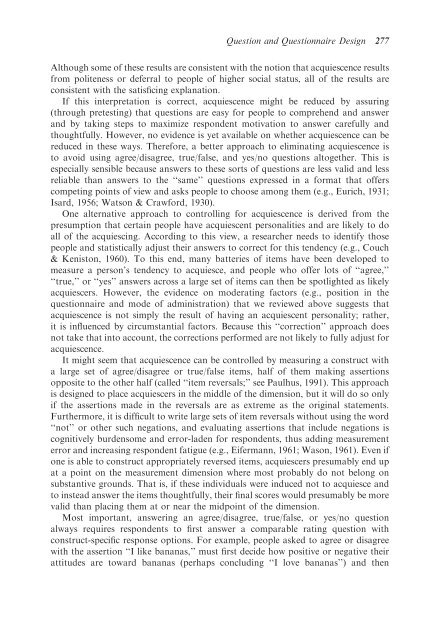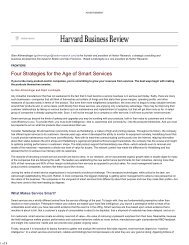Question and Questionnaire Design - Stanford University
Question and Questionnaire Design - Stanford University
Question and Questionnaire Design - Stanford University
Create successful ePaper yourself
Turn your PDF publications into a flip-book with our unique Google optimized e-Paper software.
<strong>Question</strong> <strong>and</strong> <strong>Question</strong>naire <strong>Design</strong> 277Although some of these results are consistent with the notion that acquiescence resultsfrom politeness or deferral to people of higher social status, all of the results areconsistent with the satisficing explanation.If this interpretation is correct, acquiescence might be reduced by assuring(through pretesting) that questions are easy for people to comprehend <strong>and</strong> answer<strong>and</strong> by taking steps to maximize respondent motivation to answer carefully <strong>and</strong>thoughtfully. However, no evidence is yet available on whether acquiescence can bereduced in these ways. Therefore, a better approach to eliminating acquiescence isto avoid using agree/disagree, true/false, <strong>and</strong> yes/no questions altogether. This isespecially sensible because answers to these sorts of questions are less valid <strong>and</strong> lessreliable than answers to the ‘‘same’’ questions expressed in a format that offerscompeting points of view <strong>and</strong> asks people to choose among them (e.g., Eurich, 1931;Isard, 1956; Watson & Crawford, 1930).One alternative approach to controlling for acquiescence is derived from thepresumption that certain people have acquiescent personalities <strong>and</strong> are likely to doall of the acquiescing. According to this view, a researcher needs to identify thosepeople <strong>and</strong> statistically adjust their answers to correct for this tendency (e.g., Couch& Keniston, 1960). To this end, many batteries of items have been developed tomeasure a person’s tendency to acquiesce, <strong>and</strong> people who offer lots of ‘‘agree,’’‘‘true,’’ or ‘‘yes’’ answers across a large set of items can then be spotlighted as likelyacquiescers. However, the evidence on moderating factors (e.g., position in thequestionnaire <strong>and</strong> mode of administration) that we reviewed above suggests thatacquiescence is not simply the result of having an acquiescent personality; rather,it is influenced by circumstantial factors. Because this ‘‘correction’’ approach doesnot take that into account, the corrections performed are not likely to fully adjust foracquiescence.It might seem that acquiescence can be controlled by measuring a construct witha large set of agree/disagree or true/false items, half of them making assertionsopposite to the other half (called ‘‘item reversals;’’ see Paulhus, 1991). This approachis designed to place acquiescers in the middle of the dimension, but it will do so onlyif the assertions made in the reversals are as extreme as the original statements.Furthermore, it is difficult to write large sets of item reversals without using the word‘‘not’’ or other such negations, <strong>and</strong> evaluating assertions that include negations iscognitively burdensome <strong>and</strong> error-laden for respondents, thus adding measurementerror <strong>and</strong> increasing respondent fatigue (e.g., Eifermann, 1961; Wason, 1961). Even ifone is able to construct appropriately reversed items, acquiescers presumably end upat a point on the measurement dimension where most probably do not belong onsubstantive grounds. That is, if these individuals were induced not to acquiesce <strong>and</strong>to instead answer the items thoughtfully, their final scores would presumably be morevalid than placing them at or near the midpoint of the dimension.Most important, answering an agree/disagree, true/false, or yes/no questionalways requires respondents to first answer a comparable rating question withconstruct-specific response options. For example, people asked to agree or disagreewith the assertion ‘‘I like bananas,’’ must first decide how positive or negative theirattitudes are toward bananas (perhaps concluding ‘‘I love bananas’’) <strong>and</strong> then
















